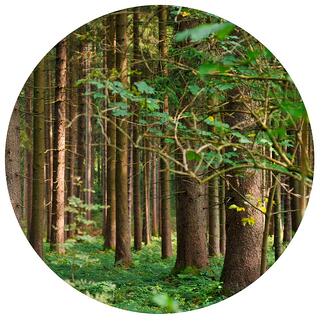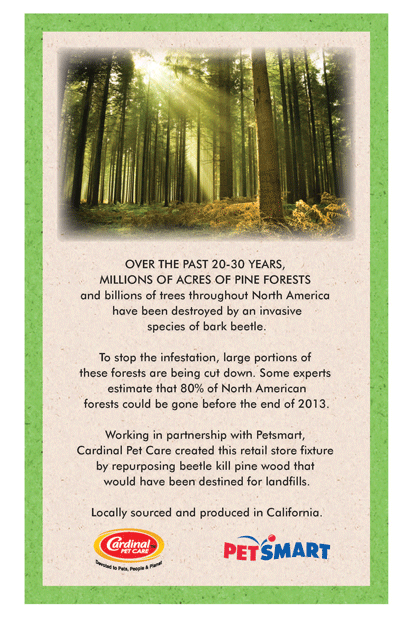
Over the last 15 years, one of North America’s greatest environmental disasters has been quietly unfolding before our eyes. An invasive species of Mountain Pine Beetle has destroyed millions of acres of pine forests and billions of trees in the Western United States, Mexico, and British Columbia. Some experts estimate that 80% of the pine forests in North America will be gone before the end this year.
Pine beetles have always played an important role in our forests’ ecosystem. They attack old or weakened trees, speeding the development of a younger, healthier forest. However, unusually hot, dry summers and mild winters brought on by climate change in recent years, along with forests filled with more mature lodgepole pine, have led to an unprecedented epidemic and the largest insect blight in the history of North America.
How Beetles Attack Trees
Mountain Pine Beetles attack pine trees by burrowing into a tree and laying eggs under the bark. The eggs hatch into larvae which block water flow and cut off nutrients, killing the tree and leaving behind a fungus which assists the beetles in killing the trees while also staining the wood in inky streaks that range from grayish-blue to indigo. The beetles target trees with the thickest layer of phloem- the inner layer that larvae feed on. This means they typically target trees that are at least 8” or larger in diameter and 80 years or older. However, under epidemic or outbreak conditions, small diameter trees may also be infested. Coordinated mass attacks by beetles are common. When adult beetles find a suitable host, they send out a pheromone telling new insects to find another home. The joint action of larval feeding and fungal colonization kills the host tree within a few weeks. Once the tree is infested, it cannot be saved. When the tree is first attacked, it remains green. Usually within a year of attack, the needles will have turned red. In 3 to 4 years after the attack, very little foliage is left, so the trees appear gray. Foresters worry that in the first few years after dying, the beetle-kill trees become like huge tinderboxes which are prone to bursting into fast-moving fires.
Challenges of Beetle Population Control

Controlling the beetle population is extremely challenging. Other than certain insects and birds, particularly woodpeckers, pine beetles have few natural predators. They are incredibly resilient insects. Mountain Pine Beetle larvae are able to survive extreme winter temperatures by metabolizing an alcohol called glycerol that acts as an antifreeze. For freezing temperatures to affect a large number of larvae during the middle of winter, temperatures of at least 30 degrees below zero must be sustained for at least 5 days. Beetle populations can survive temperatures of 110 degrees under the bark. Chemical control options for the Mountain Pine Beetle larvae have been greatly limited in recent years as there are no labeled pesticides for use on this pine beetle species. The beetle epidemic is now on the decline since like a cancer, beetles kill their host, and as the numberof suitable hosts decline so does the beetle population. However, the envrionmental devastation remains.
Ecosystem Devastation
The downstream effects of the Mountain Pine Beetle epidemic are significant. The U.S. Forest Service and land owners have been forced to cut down large portions of pine forests to reduce the risk of wildfires and to create the space necessary for new trees to grow. The incidence of wildfires has increased dramatically in recent years, resulting in a significant increase in air pollution. The Canadian Forest Service estimates that by 2020, the pine beetle outbreak will release 270 megatonnes of carbon dioxide into the air from Canadian Forests. Researchers from the University of Colorado have concluded that dead forests will accumulate more snowpack as a result of thinner tree canopies and decreased snow sublimation. The thin canopies also cause faster snow melt by allowing more sunlight through to the forest floor, thereby lowering the snowpack. Low water flow impacts the trout and salmon population and affects animals throughout the ecosystem.

Using Beetle Kill Pine to Make Wood Store Fixtures and Wood POP Displays
Pine trees that have succumbed to Mountain Pine Beetles generally maintain their structural integrity and can be used to make wood displays and retail store fixtures in addition to being used for other décor and building applications. Beetle Kill Pine wood often looks like regular pine wood and is perfectly safe to use for commercial applications and building projects. Blue stained Beetle Kill Pine is generally in shorter supply and is therefore more expensive than regular Beetle Kill Pine. Because of the magnitude of the devastation and the need to clear the dead forests, much of this wood is destined for landfills so being able to build a store display out of Beetle Kill Pine is perhaps the best thing you can do for the environment.
Beetle Kill Pine can make attractive point of purchase displays when unfinished. It can also be stained to create different looks. We have used Beetle Kill Pine to make a variety of wood displays, including the Big B’s shelf display shown here.
Using Beetle Kill Pine also represents a great marketing opportunity to let shoppers know that your company is committed to helping the environment. We have designed signs for some of our customers that communicate the Beetle Kill story and reinforce the company’s commitment to the environment. One example is the sign we designed for Cardinal Pet Care.
Beetle Kill Pine is not only cost effective, but it is extremely eco-friendly and has great story value. Consider making your next wooden display out of Beetle Kill Pine.
Jim Hollen is the owner and President of RICH LTD. (www.richltd.com), a 35+ year-old California-based point-of-purchase display, retail store fixture, and merchandising solutions firm which has been named among the Top 50 U.S. POP display companies for 9 consecutive years. A former management consultant with McKinsey & Co. and graduate of Stanford Business School, Jim Hollen has served more than 3000 brands and retailers over more than 20 years and has authored nearly 500 blogs and e-Books on a wide range of topics related to POP displays, store fixtures, and retail merchandising.
Jim has been to China more than 50 times and has worked directly with more than 30 factories in Asia across a broad range of material categories, including metal, wood, acrylic, injection molded and vacuum formed plastic, corrugated, glass, LED lighting, digital media player, and more. Jim Hollen also oversees RICH LTD.’s domestic manufacturing operation and has experience manufacturing, sourcing, and importing from numerous Asian countries as well as Vietnam and Mexico.
His experience working with brands and retailers spans more than 25 industries such as food and beverage, apparel, consumer electronics, cosmetics/beauty, sporting goods, automotive, pet, gifts and souvenirs, toys, wine and spirits, home improvement, jewelry, eyewear, footwear, consumer products, mass market retail, specialty retail, convenience stores, and numerous other product/retailer categories.
